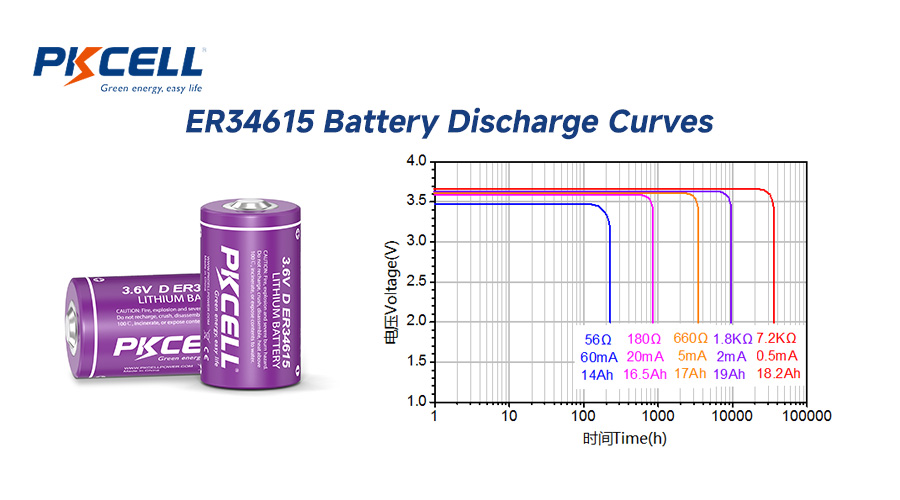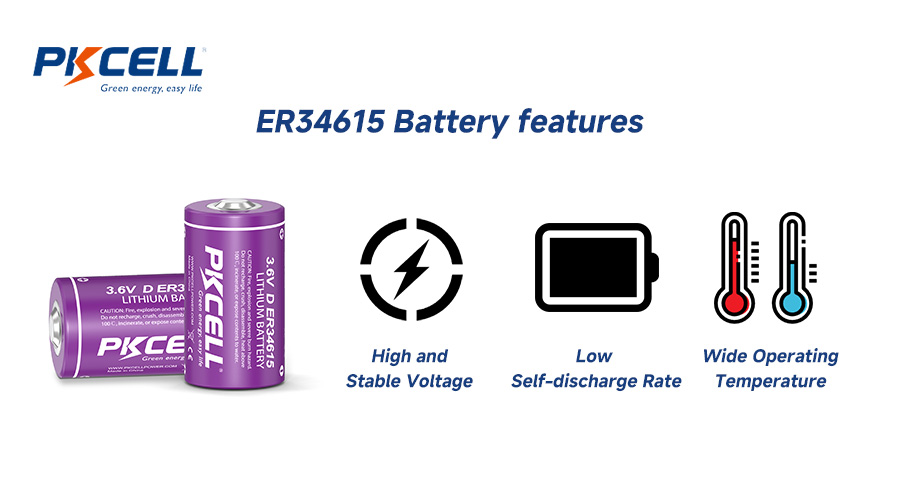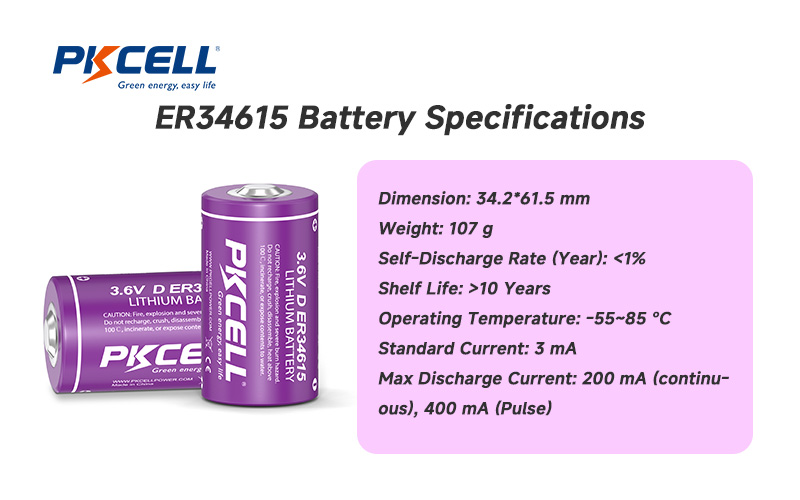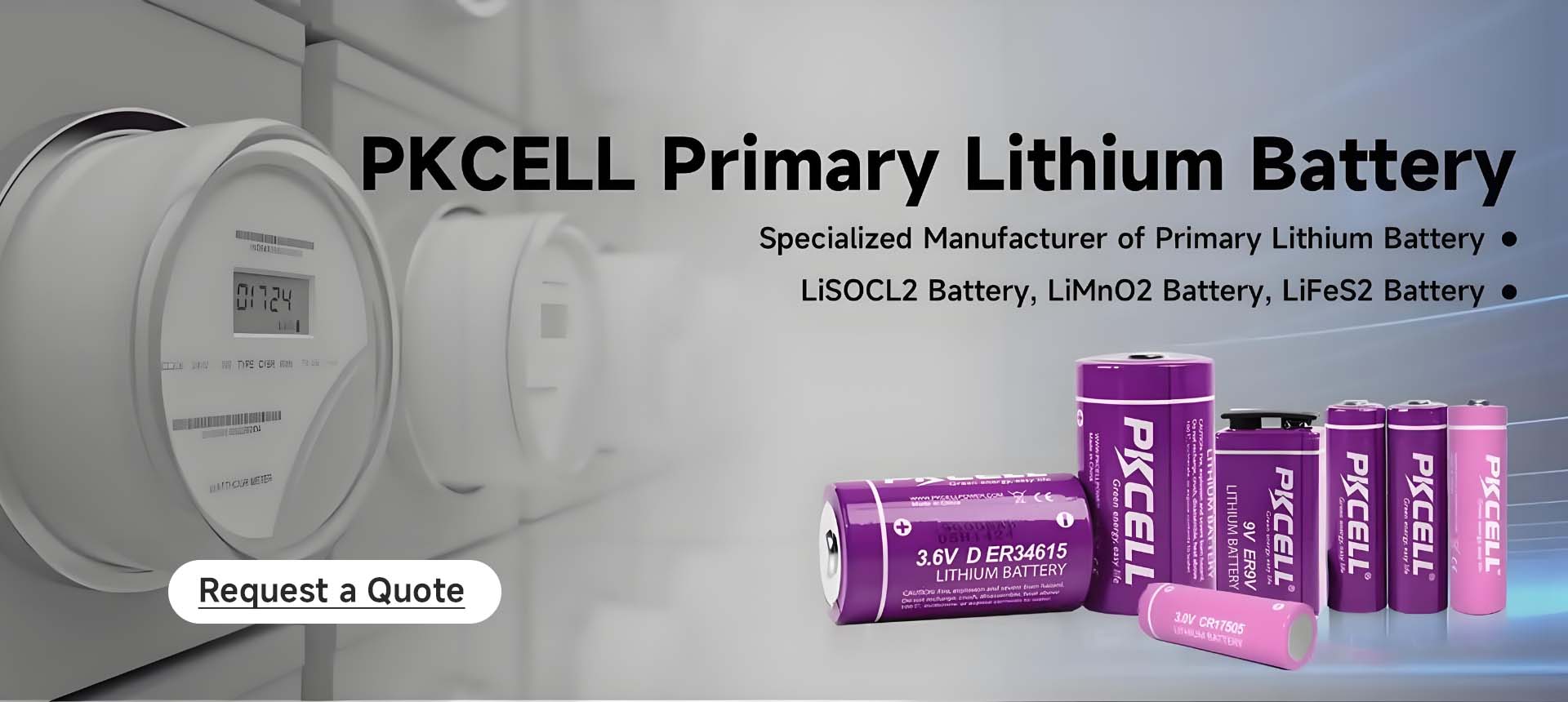Key Highlights
- The ER34615 is a 3.6V, 19Ah high-energy Lithium Thionyl Chloride cell, which is suitable for smart meters.
- It can operate 10–15 years continuously in low-drain devices, so people do not need to change them often.
- It has a low discharge rate, which is ≤1% per year for long-term storage and deployment.
- The battery operates from -55°C to +85°C without performance loss, suitable for outdoor work in extreme weather.
Why Power Reliability Is Critical for Smart Metering
In the smart metering industry, battery choice is more than a technical decision—it’s a long-term operational strategy. Smart water, heat, and flow meters are often installed in underground pits, meter boxes, or remote utility cabinets. Sending technicians to replace batteries not only increases labor costs but also disrupts service and data continuity. That’s why utilities, OEMs, and integrators seek a “fit-and-forget” solution, and the ER34615 batteries do exactly what people want.
ER34615 Battery Overview & Core Benefits
The ER34615 is a primary (non-rechargeable) Lithium Thionyl Chloride (Li-SOCl₂) cell designed for ultra-low-drain applications. Its bobbin construction provides exceptional energy density and stability, making it ideal for smart meters. Its stable 3.6 voltage ensures accurate reading of smart meters. Its low discharge rate of ≤1% per year means that the meters will need minimal maintenance over a decade or more. Being able to work in a wide range of temperatures from -55°C to +85°C, it provides reliable performance in varying climates and environments. Below is a specification table of er34615. You can also down its datasheet to learn more.
Specifications Table
| Parameter | Value |
| Chemistry | Lithium Thionyl Chloride (Li-SOCl₂) |
| Nominal Voltage | 3.6V |
| Typical Capacity | 19Ah |
| Size | C size (34mm × 61.5mm) |
| Self-Discharge Rate | ≤1% per year |
| Operating Temp. | -55°C to +85°C |
| Expected Life | 10–15 years |
Deep Dive – Why the ER34615 Excels in Smart Water Meters
Ultra-Low Self-Discharge for Long-Term Deployment
Smart water meters may be deployed for over a decade without battery replacement. The self-discharge rate of ER34615 is ≤1% per year, ensuring that stored energy is maintained, even when devices remain dormant for months before installation.
Stable Voltage Output for Accurate Readings
In metering applications, voltage stability is critical for precise data transmission. A sudden drop can cause reading errors or transmission failures. The ER34615 maintains a flat discharge curve, ensuring consistent output throughout its lifespan.
Resistance to Environmental Stress
From freezing winters in northern cities to humid coastal environments, smart meters face wide-ranging challenges. The ER34615 operates from -55°C to +85°C, maintaining both capacity and safety under extreme conditions.
How the ER34615 Fits in Heat & Flow Meter Applications
Heat and flow meters often operate in industrial environments where vibration, dust, and temperature swings are common. The ER34615’s robust casing, leak-proof design, and chemical stability make it well-suited for such conditions.
Compatibility with Wireless Data Transmission
Most modern heat and flow meters integrate wireless communication protocols like LoRa, NB-IoT, or Zigbee. The ER34615’s bobbin design handles low-drain operation perfectly, and when combined with a supercapacitor (SPC), it easily manages the pulse currents required during transmission bursts.
Minimizing Maintenance Costs
In industrial plants or district heating systems, access to meters may require special permits or shutdown procedures. Extending battery life from 5 years to 10+ years can result in significant cost savings in both manpower and system downtime.
Bobbin vs. Spiral Construction – Which Is Better for Smart Metering?
Lithium Thionyl Chloride batteries come in two primary designs—bobbin and spiral wound:
- The Bobbin Type (ER34615) has higher capacity and ultra-low self-discharge, ideal for low-drain applications like smart meters.
- The Spiral Wound has higher current capability but has shorter lifespan. This structure is more suitable for applications needing frequent high pulses (e.g., GPS trackers).
For smart metering, the bobbin type is the clear choice due to its long life and stable output.
Real-World Case Studies
- Water Utility Company – In a coastal city project, ER34615 paired with an SPC powered smart water meter for 12 years with zero battery failures.
- District Heating Provider – In harsh northern climates, meters operated for over a decade at -40°C, reducing maintenance visits by 80%.
- ROI Analysis – Compared to standard lithium batteries, the ER34615 cut lifecycle costs by over 30% thanks to fewer replacements and reduced field labor.
Procurement & Supply Considerations
For procurement managers and OEMs, battery selection goes beyond technical specs—it’s about supply chain stability, compliance, and integration ease:
- Timely delivery for mass-production is the top consideration for a company. The cost can be much higher if the batteries fail to deliver on time.
- If custom terminal types, solder tags, and wiring harnesses can be supplied for seamless integration into existing designs is another factor when choosing a reliable battery supplier.
- The battery should be certified to UL, UN38.3, and IEC standards, so that the ER34615 can be shipped worldwide by air or sea without delays.
Quote for ER34615 Battery Now!
Why Choose PKCELL As Your B2B ER34615 Battery Supplier?
PKCELL is a trusted B2B supplier with over 20 years of experience producing high-performance ER34615 3.6V lithium batteries. Using Li-SOCl₂ chemistry, our ER34615 batteries offer exceptional energy density, ultra-long life, and stable performance, even in extreme environments—perfect for smart metering, IoT devices, and remote monitoring systems. We focus on serving industrial clients with consistent product quality, competitive bulk pricing, and flexible supply solutions. All products are manufactured under strict quality control and certified to ISO9001, CE, and RoHS standards. Partner with PKCELL for reliable ER34615 battery supply that keeps your projects powered for the long term.
Frequently Asked Questions (FAQ)
Q1: How long can the ER34615 battery last in a smart water meter?
A: In most smart metering applications, the PKCELL ER34615 can deliver reliable power for 10–15 years without the need for replacement. This long service life is possible thanks to its high capacity (19Ah) and ultra-low self-discharge rate, which preserves stored energy over extended periods.
Q2: Can the ER34615 handle high pulse loads for wireless communication?
A: Yes. While the ER34615 is designed for low-drain operation, it can handle the brief high-current pulses required by wireless modules when paired with a supercapacitor (SPC). This configuration ensures smooth power delivery during data transmissions for LoRa, NB-IoT, or Zigbee communication systems.
Q3: Is the ER34615 suitable for extreme outdoor environments?
A: Absolutely. The ER34615 operates reliably in temperatures ranging from -55°C to +85°C, making it ideal for outdoor meter boxes, underground pits, and industrial installations. Its chemical stability and leak-proof construction help it maintain consistent performance in humid, dusty, or corrosive environments.
Q4: What makes it better than other lithium batteries?
A: Compared to standard lithium cells, the ER34615 delivers higher capacity, longer operational life, and superior temperature resilience. Its ultra-low self-discharge rate and stable voltage output help prevent communication failures and inaccurate readings. For applications where battery replacement is costly or difficult, these advantages translate directly into lower total cost of ownership.
Post time: Aug-11-2025









